Patagonia lies at the southern-most tip of South America. Amid a field of ice caps and glaciers, Anthony Bourdain arrives at "the end of the world," but chooses to begin his journey in colorful Buenos Aires. Strongly influenced by European culture, Buenos Aires is sometimes referred to as the "Paris of South America". Anthony thinks it looks more like a mixture of Barcelona, Rome and Paris, but with palm trees.
Introduction:
Argentina is the second largest country in South America, after Brazil. It is the eighth-largest country in the world by land area and the largest among Spanish-speaking nations, though Mexico, Colombia and Spain are more populous. Argentina's continental area is between the Andes mountain range in the west and the Atlantic Ocean in the east.
Colonial History:
The written history of Argentina began with the arrival of Spanish chroniclers with the expedition of Juan Díaz de Solís in 1516 to Río de la Plata river, which marks the beginning of Spanish domination in this region. In 1776 the Spanish Crown established the Viceroyalty of the Río de la Plata, an umbrella of territories from which, with the Revolution of May 1810, began a process of gradual formation of several independent states, including one called the United Provinces of Río de la Plata. With the declaration of independence on July 9, 1816 and the military defeat of the Spanish Empire in 1824, a federal state was formed in 1853-1861, known today as the Republic of Argentina.
Today, with a population of 40 million people, most Argentines are descendents of colonial-era settlers and of the 19th and 20th century immigrants from Europe, with about 86% of the population being of European descent (mainly Spain and Italy). However that was not always the case.
The black population in Argentina declined since the early 19th century from 15% of the total population in 1857 (Blacks and Mulatto people), to 4% in present days (mainly mulattoes, and immigrants from Cape Verde). Afro-Argentines were up to a third of the population during colonial times, most of them slaves brought from Africa to work for the criollos. The 1813 Assembly abolished slavery, and led to the Freedom of Wombs Law of 1813, which automatically freed slaves' children at birth. The first elected president of Argentina, Bernardino Rivadavia, was a mulatto and during his brief term in office (February 8, 1826 to July 7, 1827) his political opponents and Federalist enemies referred to him as "Doctor Chocolate".
Post Independence:
During the wars of independence (1810–21) and the War of the Triple Alliance (1865–70), the male cohort within this ethnic group was reduced when thousands of black citizens were forcefully recruited and used as front-line soldiers; most of the remainder (primarily Afro Argentine women) were absorbed by intermarriage into the general population, a development which, in part, resulted from policy of Blanqueamiento ("white-washing") advanced by President Domingo Sarmiento in the 1870s.
Argentina increased in prosperity and prominence between 1880 and 1929 and emerged as one of the ten richest countries in the world, benefiting from an agricultural export-led economy as well as British and French investment. The country was neutral during World War I and most of World War II, becoming an important source of foodstuffs for the Allied Nations.
In 1929, Argentina had the world's fourth highest per capita GDP. These years of prosperity ended with the Crash of 1929 and the ensuing worldwide Great Depression. A military coup initiated the period known as the "Infamous Decade", characterized by electoral fraud, persecution of the political opposition (mainly against the UCR) and pervasive government corruption, against the background of the global depression.
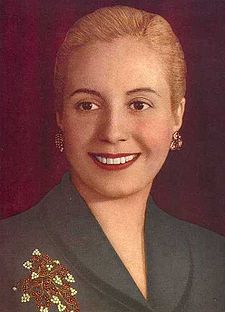 In 1946, General Juan Perón was elected president, creating a populist movement referred to as "Peronism". His wife Eva was popular and played a central political role until her death in 1952, mostly through the Eva Perón Foundation and the Female Peronist Party, as women's suffrage was granted in 1947. During Perón's tenure, wages and working conditions improved appreciably, unionization was fostered, strategic industries and services were nationalized, as well as urban development being prioritized in the agrarian sector.
In 1946, General Juan Perón was elected president, creating a populist movement referred to as "Peronism". His wife Eva was popular and played a central political role until her death in 1952, mostly through the Eva Perón Foundation and the Female Peronist Party, as women's suffrage was granted in 1947. During Perón's tenure, wages and working conditions improved appreciably, unionization was fostered, strategic industries and services were nationalized, as well as urban development being prioritized in the agrarian sector.
Formerly stable prices and exchange rates were disrupted however: the peso lost around 70% of its value from 1948 to 1950, and inflation reached 50% in 1951. Foreign policy became more isolationist, straining US-Argentine relations. Perón intensified censorship as well as repression and numerous opposition figures were imprisoned and tortured. A violent coup deposed him in 1955. He fled into exile, eventually residing in Spain.
Though repressive, this new regime continued to encourage domestic development and invested record amounts into public works. The economy grew strongly and income poverty declined to 7% by 1975. Partly because of their repressiveness, however, political violence began to escalate and Perón, still in exile, skillfully co-opted student and labor protests which eventually resulted in the military regime's call for free elections in 1973, and Perón's return from Spain.
Taking office that year, Perón died in July 1974 leaving his third wife Isabel, the Vice President, to succeed him in office. Mrs. Perón had been chosen as a compromise among feuding Peronist factions who could agree on no other running mate; secretly though, she was beholden to Perón's most fascist advisers. The resulting conflict, between left and right-wing extremists, led to mayhem, financial chaos and a coup d'état in March 1976 which removed her from office.
The Dirty War was a period of state-sponsored violence in Argentina from 1976 until 1983. Victims of the violence included several thousand left-wing activists, including trade unionists, students, journalists, Marxists, Peronist guerrillas and alleged sympathizers, either proved or suspected. Estimates for the number of people who were killed or "disappeared" range from 9,000 to 30,000. The new dictatorship brought some stability at first, and built numerous important public works, but frequent wage freezes and deregulation of finance led to a sharp fall in living standards and record foreign debt. Deindustrialization, the peso's collapse, and crushing real interest rates, as well as unprecedented corruption, public revulsion over the Dirty War, and finally the 1982 defeat by the British in the Falklands War, discredited the military regime and led to free elections in 1983 which marked the return of Democracy.
Present Day:
Today Argentina is a recognized middle power, Argentina is Latin America's third-largest economy, with a high rating on the Human development index. Within Latin America, Argentina has the fifth highest nominal GDP per capita and the highest in purchasing power terms. Argentina has a market-oriented economy with abundant natural resources, a well-educated population, an export-oriented agricultural sector and a relatively diversified industrial base. However, high inflation has been a weakness of the Argentine economy for decades. Officially hovering around 9% since 2006, inflation has been privately estimated at over 20%.
Argentine cuisine is distinctive in South America because of its strong resemblance to Spanish, Italian, French and other European cuisines while the cuisine of the Argentine Northwest has more elements of Andean cuisine. Another determining factor in Argentine cuisine is that the country is one of the world's major food producers. It is a major producer of meat (especially beef), wheat, corn, milk, beans, and since the 1970s, soybeans. Given the country's vast production of beef, red meat is an especially common part of the Argentine diet.
Buenos Aires:
Buenos Aires is the capital and largest city of Argentina, and the second-largest metropolitan area in South America, after São Paulo, Brazil. Buenos Aires is considered an Alpha World City. It is the political, financial, industrial, commercial, and cultural hub of Argentina. Its port is one of the busiest in South America.
Demographics:
According to the census of 2010, there are 15.5 million people residing in the city of Buenos Aires and 24 surrounding districts, with approximately 3 million in living in Buenos Aires proper. The racial makeup of the city is 88.9% White, 7% Mestizo, 2% Asian and 1% Black ("Afro-Argentine"). However, the exact number of Afro-Argentine is actually quite difficult to calculate. Many blacks that could used to “pass” for mulatto or white, so for this reason, people may or may not be aware that they had a black great grandparent.
Recent genetic studies by a group of researchers belonging to diverse scientific Argentine and French institutions (CONICET, UBA, Centres D'Anthropologie de Toulouse), on the base of information gathered in the Hospital Italiano de Buenos Aires, concluded that the genetic average admixture of the Argentine population contains 79.9% of European contribution, 15.8% Amerindian and 4.3% African.
In an article recently published in the Discover Magazine, a genetic study of 249 unrelated males revealed that Argentineans carried a large fraction of European genetic heritage in their Y-chromosomal (94.1%) and autosomal (78.5%) DNA, but their mitochondrial gene pool (normally inherited exclusively from the mother) is mostly of Amerindian ancestry (53.7%); instead, African heritage was small in all three genetic systems (<4%). Serial matings between European men and mixed women diluted the autosomal contribution of Africans and Amerindians as the 'mixed" women themselves progressively became more European in ancestry.
The point is, for a country that prides itself in being so European, unlike Mexico which takes great pride in being a cultural and biological synthesis between European and native, the median Argentinean probably has enough indigenous ancestry to qualify as a Native American tribal member in the United States by the rules of blood quantum (on the order of 20-25%).
The majority of porteños (what the people of Buenos Aires call themselves) are of Italian and Spanish descent. Other European origins include German, Swedish, Dutch, Greek, Irish, Norwegian, Portuguese, French, Russian, Croatian, English and Welsh. In the 1990s there was a small wave of immigration from Romania and Ukraine. There is a minority of old criollo stock, dating back to the Spanish colonial days, which has increased mostly as a result of immigration from countries such as Bolivia, Peru and Paraguay since the second half of the 20th century.
Important Syrian-Lebanese and Armenian communities have had a significant presence in commerce and civic life since the beginning of the 20th century. The Jewish community in Greater Buenos Aires numbers around 250,000, and is the largest in Latin America. The first major East Asian community in Buenos Aires was the Japanese, mainly from Okinawa. Starting in the 1970s, there has been an important influx of immigration from China and Korea.
Since 2004, an increasing number of American and British citizens are moving to Buenos Aires, possibly due to the lower cost of living, many of them opening up businesses and some restaurants have become English-speaking favorites.
Tourism:
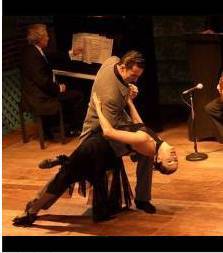 Tourism in Buenos Aires in has been growing since 2002. In a survey by the travel and tourism publication Travel and Leisure Magazine in 2008, travelers voted Buenos Aires the second most desirable city to visit after Florence, Italy. Buenos Aires, regarded as the "Paris of South America," offers elegant architecture, exquisite cuisine, a legendary nightlife, and fashionable shopping. The most popular tourist sites are found in the historic city core, comprising
Montserrat and San Telmo.
Tourism in Buenos Aires in has been growing since 2002. In a survey by the travel and tourism publication Travel and Leisure Magazine in 2008, travelers voted Buenos Aires the second most desirable city to visit after Florence, Italy. Buenos Aires, regarded as the "Paris of South America," offers elegant architecture, exquisite cuisine, a legendary nightlife, and fashionable shopping. The most popular tourist sites are found in the historic city core, comprising
Montserrat and San Telmo.
Perhaps the most lasting effect of black influence in Argentina is the Tango, which charges some of the characteristics of the festivities and ceremonies that slaves developed in the so-called tango, meeting houses in which they gathered with permission from their masters. Although not yet clearly demonstrated, it is considered that even the milonga (and dance) and chacarera draw on its influence and the minstrel song; famous Afro-Argentine minstrels include Gabino Ezeiza and Higinio D. Cazón.
The pianist and composer Rosendo Mendizabal was of African descent and the author of El Entrerriano, the oldest known Argentine tango. Other Afro-Argentine musicians and composers who contributed to the early music and development of tango include Carlos Posadas, Enrique Maciel (author of the music of the waltz La Pulpera de Santa Lucía), and Zenón Rolón.
Located in San Telmo, Plaza Dorrego hosts an antiques fair on Sundays, complete with tango shows. They also have tango shows daily at the famous plaza. On weekends they involve many tourists to learn how to dance. In 2009 the tango was declared as part of the world's "intangible cultural heritage" by UNESCO.
Patagonia:
Patagonia is a geographic region containing the southernmost portion of South America. It is located in Argentina and Chile, integrating the southernmost section of the Andes mountains to the south west to the Pacific ocean, and from the east, south through the Colorado River to the Atlantic Ocean. Argentine Patagonia is for the most part a region of steppe-like plains, rising in a succession towards the Andes. The high rainfall against the western Andes (Wet Andes) and the low sea surface temperatures offshore give rise to cold and humid air masses, contributing to the ice-fields and glaciers, the largest ice-fields in the Southern hemisphere outside of Antarctica.
The first European explorers of Patagonia observed that the indigenous people in the region were taller than the average Europeans of the time, prompting some of them to believe that Patagonians were giants. The main interest in the region sparked by Antonio Pigafetta's account came from his reports of their meeting with the local inhabitants, whom they claimed to measure some nine to twelve feet in height—"...so tall that we reached only to his waist"—, and hence the later idea that Patagonia meant "big feet". This supposed race of Patagonian giants or Patagones entered into the common European perception of this little-known and distant area, to be further fuelled by subsequent reports of other expeditions and famous-name travellers like Sir Francis Drake, which seemed to confirm these accounts.
However, the Patagonian giant frenzy was to die down substantially, when in 1773 John Hawkesworth published a compendium of noted English southern-hemisphere explorers' journals, including that of James Cook and John Byron. It became clear that the people Byron's expedition had encountered were no taller than 6-foot-6-inch (1.98m), tall perhaps but by no means giants. Interest soon subsided, although awareness of and belief in the myth persisted in some quarters even up into the 20th century.
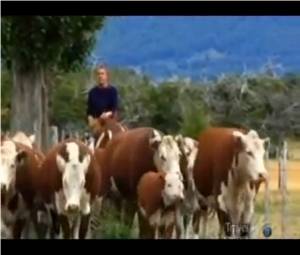 The area's principal economic activities have been mining, whaling, livestock (notably sheep throughout) agriculture (wheat and fruit production), and oil. Energy production is also a crucial part of the local economy. In the second half of the 20th century, tourism became an ever more important part of Patagonia's economy. Originally a remote backpacking destination, the region has attracted increasing numbers of upmarket visitors, cruise passengers rounding Cape Horn or visiting Antarctica, and adventure and activity holiday-makers.
The area's principal economic activities have been mining, whaling, livestock (notably sheep throughout) agriculture (wheat and fruit production), and oil. Energy production is also a crucial part of the local economy. In the second half of the 20th century, tourism became an ever more important part of Patagonia's economy. Originally a remote backpacking destination, the region has attracted increasing numbers of upmarket visitors, cruise passengers rounding Cape Horn or visiting Antarctica, and adventure and activity holiday-makers.
A spin-off from increased tourism has been the buying of often enormous tracts of land by foreigners, often as a prestige purchase rather than for agriculture. Buyers have included Sylvester Stallone, Ted Turner and Christopher Lambert, and most notably Luciano Benetton, Patagonia's largest landowner.
Argentine Patagonian cuisine is largely the same as the cuisine of Buenos Aires—grilled meats and pasta—with extensive use of local ingredients and less use of those products which have to be imported into the region. Lamb is considered the traditional Patagonian meat, grilled for several hours over an open fire.
Episode Recap:
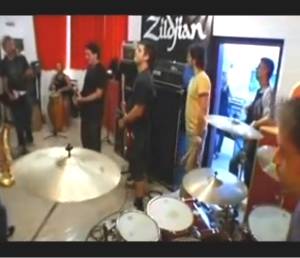 Anthony Bourdain hits the streets of Buenos Aires off and running in search of some local street food, and he's going with members of a popular local band, Los Pericos, after watching them rehearse. They chow on two of Buenos Aires popular sandwiches—choripanes (made with chorizo) and morcipanes (made with blood sausages). Then it's off to the concert.
Anthony Bourdain hits the streets of Buenos Aires off and running in search of some local street food, and he's going with members of a popular local band, Los Pericos, after watching them rehearse. They chow on two of Buenos Aires popular sandwiches—choripanes (made with chorizo) and morcipanes (made with blood sausages). Then it's off to the concert.
Music Studio: The musicians demonstrate their cooking skills to Anthony. Out on their patio, they've laid out a spread of meat and cheese that includes local favorites like mortadella and matambres. They prepare fainá, a type of thin bread made with chickpea flour (adopted from northern Italy), and pizza.
Art Studio of Marta Minujín: Anthony visits this famous internationally reknowned avant garde artist in her studio. Food is among the many mediums Marta Minujín likes to work with, recreating various icons and monuments of it; her philosophy being you must eat art in order to demystify the universal myths—the icons, monuments, and the institution—and bring them back down to earth.
Villa Miseria: Anthony heads to Villa Miseria to sample some outdoor cooking with his local journalist friend and guide, Martín. Anthony order a pig's head from the meat truck and schlep it over to Ramons, an outdoor eatery with its own barbeque pit. He trades it in for a bowl of locro, a succulent type of stew made of beans, potatoes, pumpkin, cabbage, onions and lots of pig parts such as sliced chorizo and pig tails. For dessert, roasted pig head—tongue, cheeks, brains, etc.
Bariloche: Anthony travels to Bariloche, the Swiss Alps of Argentina, situated in the foothills of the Andes. This quaint town is a replica of an authentic old Swiss town because it was settled mostly by Austrians, Germans and Italians. Anthony and his producer, Tracey Gudwin, try some paragliding. Afterwards, Anthony's paraglider pilot, Martin, invites him and the crew to attend a cookout at his lodge.
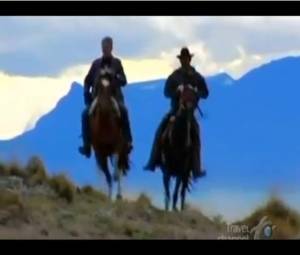 Patagonian Grasslands: Anthony joins some gauchos, Argentina's version of the cowboy, on a wild rabbit hunt on the prairies. It turns out that the real life Butch Cassidy and the Sundance Kid had a ranch not too far from where they hunt. Afterwards, they cook the hare on an open fire and wash it down with mate—both a national drink and the drink of the gauchos.
Patagonian Grasslands: Anthony joins some gauchos, Argentina's version of the cowboy, on a wild rabbit hunt on the prairies. It turns out that the real life Butch Cassidy and the Sundance Kid had a ranch not too far from where they hunt. Afterwards, they cook the hare on an open fire and wash it down with mate—both a national drink and the drink of the gauchos.
El Calafate: Anthony stops in the small Patagonia village of El Calafate, an important tourist destination en route to visit different parts of the Los Glaciares National Park. He meets up with Hector, a friend and local, and they attend a citywide barbeque in celebration of "Day of the Lake" (the day Argentina Lake was discovered).
Patagonian Ranch: Anthony visits a local ranch and witnesses the routine round up, roping, branding, and even the castration of bull calves. The testicles later become the gauchos' lunch.
Perito Moreno Glacier: Not only is the Perito Moreno Glacier one of the most visited in the world, it is also one of only three Patagonian glaciers that is growing. Due to its size and accessibility, trekking tours on the ice have gained popularity. Anthony and his two gaucho friends strap on some crampons, and strike out to scale the glacier, getting lost and enjoying some whiskey along the way.
Episodes:
 |
AUSTRALIA: Melbourne has been described as San Francisco without the fog. Anthony is off to discover what makes it so special. |
 |
BERLIN: Anthony finds himself in Berlin, a city that is for him both good and evil, Eastern and Western, repulsive and appealing. |
 |
BRAZIL: Some say São Paulo feels like LA threw up on NYC. But Anthony's back for the great food and its welcoming people. |
 |
CALCUTTA & BOMBAY: Anthony revisits his love for India's vibrant culture, cuisine & communities with a trip to Kolkata & Mumbai. |
 |
COLOMBIA: A bright and beautiful country that has gone from drug capital to food capital. Anthony explores its unique cuisine. |
 |
EGYPT: Anthony skips the long lines and tour buses, and visits with Egyptian locals to get a taste for what it means to be Egyptian. |
 |
GHANA: Anthony heads to Ghana, West Africa, a land of old forts and slave castles, and a culture filled with great food and music. |
 |
GREEK ISLES: Anthony is on a culinary odyssey to discover if Greece really does have the world's healthiest diet. |
 |
HONG KONG: A wonder-land of colors, lights and speed, a perfect marriage of modern and traditional, and home to great Asian cuisine. |
 |
IRELAND: Ireland's steeped in history and traditions, both oral & written. Anthony dispels the myths that it has the worst food on the planet. |
 |
JAMAICA: Jamaica is a vibrant, colorful land full of resorts and reggae music. Anthony is there to uncover the lesser-known Jamaica. |
 |
KOREA: Anthony gives in to his employee's pressure to visit Korea and, next thing you know, they're in Seoul and the adventure begins. |
 |
MEXICO: Carlos, a head chef in NYC and good friend, gives Anthony a culinary tour of his hometown Puebla and nearby Mexico City. |
 |
OSAKA (Japan): Anthony learns all about kuidaore, which means to bankrupt oneself with extravagance in food and drink! |
 |
PARIS: In this very first episode of the series, Anthony heads to the "City of Light" to show, at least the Americans, why the French don't suck. |
 |
PERU: Anthony is on a mission to obtain personal enlightenment in a land of ancient culture, rich cuisine, and vibrant people. |
 |
QUEBEC (Canada): Anthony is off to Québec to indulge in one of his most hedonistic pleasures–foie gras (fatty duck liver). |
 |
RAJASTHAN (India): From gorgeous sights to enticing smells, Anthony explores the magical and delicious offerings of Rajasthan. |
 |
ROME: Anthony adopts the mindset of the Roman people–living a simple life and eating fresh, seasonal ingredients. |
 |
RUSSIA: Anthony explores Russia, where the food is hearty. Along the way he meets a former Cold War spy and Miss Russia. |
 |
SHANGHAI (China): Anthony is back in China. From Shanghai to Tibet, he searches for the mythical Shangri-La. |
 |
SICILY: Anthony starts his gastronomic tour through Sicily in style by sharing a spleen sandwich with Sicily's president. |
 |
SINGAPORE: Singapore is serious about food and offers up a cuisine like no other. Anthony dives in head-first. |
 |
SPAIN: According to Anthony, outside of Asia, Spain is the single greatest place for culinary achievement in the world. |
 |
TOKYO: Anthony is off to Tokyo in search of the relationship between a perfect piece of sushi and a perfect knife blade. |
 |
TUSCANY: Anthony travels to the beautiful Tuscan countryside to visit with friends and enjoy some homemade pasta that's out of this world. |
 |
URUGUAY: Anthony and his brother are on a mission to connect with their roots in Uruguay after learning that Bourdains once settled here. |
 |
VANCOUVER (Canada): Anthony visits Vancouver, home to a thriving film industry, gorgeous scenery, and an evolving food scene. |
Contact Us | Shop | Sitemap | Join Our Team | Investors | Advertise | Web Design Services
Community | Foodies' Choice | Meetup Groups | Chat | Blogs | Forums | Submit Your Site | Resources
